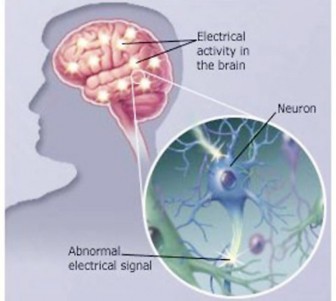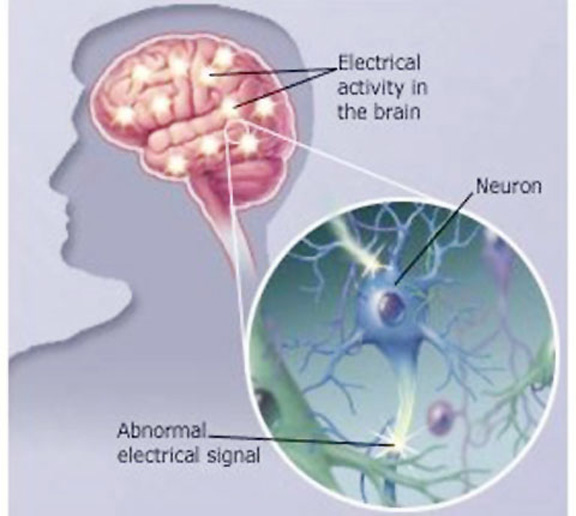People often use the words “seizure” and “convulsion” as synonyms, but they don’t mean exactly the same thing. Abnormal electrical activity in the brain can cause a seizure and the symptoms of a seizure vary. Seizures can trigger convulsions, or uncontrollable shaking of the body.
Seizures happen without much warning. Symptoms differ from one person to another, depending on what part of the brain the seizure affects. Examples of symptoms include a sudden upswing or decline in emotions, changes in vision and loss of muscle control.
 Many medical conditions cause seizures. Some are temporary. Infants, for instance, sometimes experience seizures and convulsions when they have a high fever. Other causes of seizure are more serious, such as a brain tumour, dementia and kidney failure. Seizures and convulsions (also known as fits) also may be caused by an inherited medical condition called epilepsy. Medication usually controls epilepsy.
Many medical conditions cause seizures. Some are temporary. Infants, for instance, sometimes experience seizures and convulsions when they have a high fever. Other causes of seizure are more serious, such as a brain tumour, dementia and kidney failure. Seizures and convulsions (also known as fits) also may be caused by an inherited medical condition called epilepsy. Medication usually controls epilepsy.
You might need to seek medical help for someone whose seizure or convulsion lasts for more than a few minutes. Typically, the condition lasts for a period ranging from about 30 seconds to two minutes. Find medical attention immediately if someone experiences a series of seizures while remaining unconscious.
Mini seizures
People experience mini seizures differently. In general, during mini seizures people experience a lack of control, dream-like state, or loss of consciousness. Some people experience the feelings of dread or terror; yet others lose so much control over their bodies that they fall and hurt themselves.
People lose the ability to speak, stand, think and/or move during seizures. Your mind becomes blank and you often do not know you are having a seizure as it is occurring. Only afterwards do you realize that you had a seizure.
You can also have dreams and nightmares during seizures. Even though the seizures only last for a few seconds, you remember distinct dreams and feelings, but usually cannot articulate exactly what occurred in them. Negative feelings of fear or anxiety are also common.
You can also “freeze up” or collapse during a seizure. Depending on location, this can be very dangerous and injuries do occur. You often do not feel the pain of falling during the seizure, but do afterwards, when your brain begins functioning normally again.
 Seizures can cause brain injury and sudden death when uncontrolled. The best way to prevent injury or death from seizures is to prevent them from occurring.
Seizures can cause brain injury and sudden death when uncontrolled. The best way to prevent injury or death from seizures is to prevent them from occurring.
People with epilepsy have 15 to 19 times higher risk of drowning compared to people without epilepsy. The bathtub is the most common place for a person with seizures to die, and the second is the pool. Children may have a lower risk of drowning than adults because they are more likely to be under the supervision of a parent or caregiver.
Febrile seizures
A very high fever in children can lead to a febrile seizure. It starts with contractions of the face, trunk, arms and leg muscles followed by intermittent moments of relaxation and a rhythmic jerking of the body. The eyes of the child may have a fixed stare or roll back. He may pass urine or vomit, stop breathing, or appear non-responsive and extremely drowsy. Though it’s possible for a severe attack of febrile seizure to cause death, it’s very rare.
Falls
Seizures can cause muscles to suddenly lose strength, causing people to drop things and fall to the ground. At times they may lose consciousness. Many people with seizures injure themselves when they fall, so they may choose to use protection such as helmets to protect their head.
Lapse of consciousness
Absence seizure (also known as petit mal) occurs most often in children and causes a sudden lapse of conscious activity. The child may appear to stare into space for a few seconds. While seemingly mild, these seizures can be very dangerous if they happen while the child is climbing, crossing a street or participating in other potentially dangerous activities.
Seizures during pregnancy
A tonic-clonic seizure (formerly known as “grand mal”) is a severe seizure that can involve loss of consciousness, rigidity, convulsing and falls. This condition in a pregnant woman is dangerous for a developing foetus, especially in the last trimester. A fall can injure the unborn child, and the mother’s temporary interruption of breathing during the seizure deprives the foetus of oxygen to the brain.
Status epilepticus
Status epilepticus is a continuous state of seizure that can cause death or brain damage. Seizures are considered an emergency if they last longer than 5 minutes or if a person has multiple seizures and does not arouse. The Epilepsy Foundation estimates that 42,000 deaths and thousands more incidences of brain damage follow episodes of status epilepticus every year.
Sudden death
The London-based medical journal, Lancet, reports new information on the prevalence of the sudden death syndrome among patients with poorly controlled seizures. About 10 to 15 of 10,000 patients with severe epilepsy die unexpectedly each year.
Trigger factors don’t necessarily cause epilepsy but might provoke a single seizure, even if your epilepsy is under control. Keeping a seizure journal and jotting down any triggers that invoke a seizure might help you develop your own list of triggers.
Medication
If you miss a dose of your anti-epileptic medication, you are at risk for provoking an epileptic episode. The longer you go without your prescription medicine, the more severe your seizures could become. Abruptly stopping and withdrawing from other prescription medication, such as antidepressants, painkillers, or Lithium, can also induce seizure activity in the brain and possibly an actual epileptic episode.
Alcohol
Most epileptic patients can safely drink two alcoholic drinks at a time; for this purpose, an average drink equals a 100 ml of a glass of wine or a 285 ml mug of beer. However, some epilepsy sufferers cannot handle that much alcohol because alcohol diminishes the effectiveness of the medication, and the interaction of the medication and alcohol makes them extra drowsy, affecting concentration and coordination. When epilepsy sufferers drink too much, poor concentration leads to forgetting their medication and skipping meals, provoking a seizure.
Stress
Negative emotions such as intense worry and anger might trigger a seizure, particularly if you are so overwhelmed you are losing sleep about the issue. Physical stress issues like excessive vomiting and diarrhoea might precipitate seizures. Epilepsy sufferers could try practicing relaxation therapy in addition to taking a yoga class or aerobics to decrease their stress level.
Menstruation
Some women experience catamenial epilepsy, having a seizure right before or during their period. This condition is triggered by an increase in hormone levels, fluid retention and a change in the blood levels of your medicine. If you exhibit these types of seizures, speak to your neurologist about changing your medication dose.
Photosensitivity
Some children suffer from reflex epilepsy. This condition involves the sensitivity to contrasting patterns, such as strobe lights, video games or the television screen.
The flicker frequency and the distance from the screen might determine how high the risk of triggering seizures is. Traditional cathode ray tube (CRT) computer monitors periodically refresh or repaint the screen at a certain frequency, measured in cycles per second or Hertz (Hz). Refresh rates below 100Hz can cause the screen to flicker and induce a seizure. Flat-screen liquid crystal display (LCD) monitors do not refresh, and present no such risk.
Ideally, the environment in which a computer is used should be lit naturally, but, even so, placement of a monitor or screen is important in preventing seizures. A monitor placed facing a window will force the user to switch focus back and forth between the relatively dark monitor and the light background; the contrast in brightness may be enough to trigger a seizure.
Persons can decrease photo sensitivity seizures by wearing wraparound sunglasses to minimize glare. This information is not intended as a substitute for professional medical advice or treatment. (ehow)










